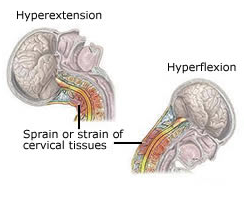 ALSO KNOWN AS HYPEREXTENSION-HYPERFLEXION – Whiplash is the term which describes pain in the cervical region after the specific mechanism of hyperflexion and hyperextension. This commonly occurs during motor vehicle accidents.
ALSO KNOWN AS HYPEREXTENSION-HYPERFLEXION – Whiplash is the term which describes pain in the cervical region after the specific mechanism of hyperflexion and hyperextension. This commonly occurs during motor vehicle accidents.
The neck (cervical spine) is composed of vertebrae which begin in the upper torso and end at the base of the skull. The bony vertebrae along with the ligaments (like thick rubber bands) provide stability to the spine. The muscles allow for support and motion. The neck has a significant amount of motion and supports the weight of the head. However, because it is less protected and more mobile than the rest of the spine, the neck can be vulnerable to motion related disorders producing pain and restricted motion. For most people, the neck pain is a temporary condition that disappears with time.
Signs and symptoms
People who experience whiplash may develop one or more of the following symptoms, usually within the first two days after the accident:
- Neck pain and stiffness
- Headaches
- Pain in the shoulder or between the shoulder blades
- Low back pain or thoracic back pain
- Pain or numbness in the arm and/or hand
- Difficulty concentrating or remembering
- Irritability, sleep disturbances, fatigue
Diagnosis
During the physical exam, your doctor will ask you how the injury occurred, measure range of motion and check for any point tenderness. Your orthopaedist may request x-ray studies to look closely at the bones in your neck. This evaluation helps eliminate or identify other sources of neck pain, such as spinal fractures, dislocations, arthritis and other serious conditions.
Treatment
All sprains and strains, no matter where they are located in the body, receive basically the same type of treatment. Usually neck sprains, like other sprains, will gradually heal given time and appropriate treatment. You may have to wear a soft cervical collar to help support the head and relieve pressure on the neck so the ligaments have time to heal.
Analgesics can help reduce the pain and any swelling. Muscle relaxants can help ease spasms. You can apply an ice pack for 15-30 minutes at a time, several times a day for the first two or three days after the injury. This will help reduce inflammation and discomfort. Although heat, particularly moist heat, can help loosen cramped muscles, it should not be applied too quickly.
Rarely does the treatment of whiplash require surgery. Because the term whiplash simply describes a mechanism of injury, all types of injury due to whiplash are included in a classification of “whiplash associated disorders” or WADs. At their most severe, although rare, WADs may involve broken bones or nerve damage and these may require some form of surgery.
Other treatment options include:
- Massaging the tender area
- Ultrasound
- Cervical traction
- Aerobic and isometric exercise
- Physiotherapy
Prognosis
Generally, the prognosis for individuals with whiplash is good. The neck and head pain clears within a few days or weeks. Most patients recover within 3 months after the injury however some may continue to have residual neck pain and headaches.
